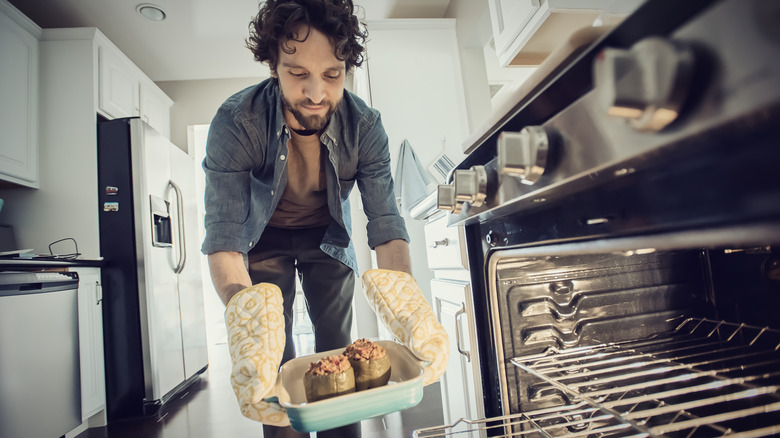Conventional Or Convection? Here's What You Need To Know Before Your Next Oven Purchase
Along with the drip coffeepot and double boiler, an English Count is credited with inventing the first stove that could heat more than one pot at a time at different temperatures at the end of the 1700s. Around 100 years later, the first electric stove patent was issued. By the 1960s, the demand for electricity had skyrocketed thanks to the growing popularity of appliances like vacuum cleaners, washing machines, and the electric oven. Before long, the modern range became one of the kitchen appliances people can't live without.
There's still debate today about whether a gas or electric oven is best. Gas provides high heat immediately, while electricity takes longer to heat up but provides more consistent temperatures, even low ones. Based on energy costs in your area, operating a gas range may end up costing slightly more. Both conventional and convection ovens are available with either hookup, but which works the best? It depends on your budget and cooking needs. To make the best choice, determine the right size for your range or wall unit, be realistic about your overall budget, and note the kinds of foods you prepare most often.
Conventional oven pros and cons
Most people are familiar with conventional ovens, which are more commonly used in home kitchens today. They typically have two heating elements — one for baking on the bottom and one for broiling on the top. Oven racks can be moved depending on what you're cooking. To brown the surface of casseroles or fish, exposure to the top element works best. To get a crispy crust on cookies or biscuits, the bottom element works better. Bob's Red Mill recommends using a conventional oven for baked goods that require rising to make sure the outside of your cakes and breads don't cook too quickly. Unlike a convection oven, a conventional model doesn't rely on a fan, so for dishes with longer cooking times — like roasts — positioning racks in the middle provides the highest air circulation and most even distribution of heat.
It's important to pay attention to signs that your oven is too old. If a limited budget is a factor in your next purchase, conventional options are typically cheaper than convection models. It's relatively easy to find a freestanding electric range for just over $500, where a similarly-sized convection may start closer to $1,000. Along with the lower price tag, most recipes are written with convection ovens in mind because they're more common. This means that you won't have to make major adjustments for cooking times or temperatures when you're making your favorite dishes.
When to consider a convection oven instead
Traditional ovens might not be the best choice for tiny house kitchens, time-pressed home chefs, or anyone who wants the most energy-efficient appliances available. Convection ovens differ from conventional models because they have fans and exhaust systems that constantly circulate the hot air inside them. They also often have a third heating element that contributes to faster cooking times than are achieved with their conventional counterparts. Because the food cooking in a convection oven has hot air continuously blowing over and around it, dishes can be heated at lower temperatures. As long as you aren't cooking treats that start off as wet batter, like flans or soufflés, using a convection oven can also create better textures like crispy chicken skin and flakey croissants.
According to Energy Star, shorter cooking times combined with lower temperatures result in convection ovens using 20% less energy than conventional options. Although this may save you money in the long run, convection models are more expensive. Top-of-the-line products can cost thousands of dollars. Countertop versions are available for less than an electric range, but they take up valuable space and don't offer the same cooktop features.


